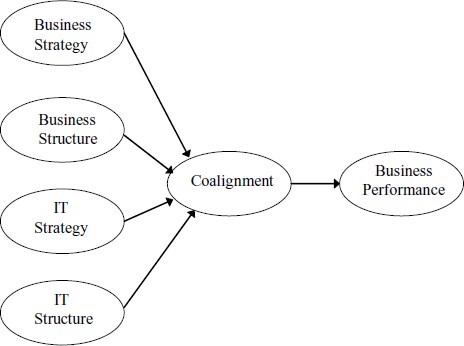Deploying, monitoring and sustaining a SISP is a key ingredient of alignment (Wilkin & Cerpa, 2012). The process is iterative and usually of a longer-term duration (Doherty et al, 1999). This section explains a general SISP deployment model and how to measure and sustain the implementation over a period of years.
Measuring ISP
Many firms are endeavouring to align IS with the business. Figure below presents a summary of this process, captured in SAM model (Strategic Alignment Model).
(Bergeron et al., 2004, p. 1007)
Measuring SISP is important to prove alignment between IT and the Business. An effective model is one developed by Delone & McLean (2003). Measuring SISP can be achieved by assessing the following 3 critical factors: 1) information, 2) system, and 3) service quality. By measuring these 3 areas, a frim can determine IT usage and end-user satisfaction. Metrics will determine if the SISP is returning a positive or negative business return (Chen et al 2010).
(Adapted from Delone & Mclean, 2003)
The boxes on the left summarise the KSFs for the categories of Information Quality, System Quality, and Service Quality. If the KSFs are in place and effective, then user intention and satisfaction should result in more frequency, intensity and durability of system usage (Benroider, 2008). These in turn should generate net benefits to the business.
The above model is supported by academic research. Some investigations have found that there are ‘exemplary measures’ of for example, System Quality. These include: Ease of System or Application Access, Reliability Flexibility, Integration and Data Accuracy (Gable et al 2008); Convenience (in Ferguson, 2012); and Interactivity (Kearns, 2006), amongst others. These examples of System Quality should positively impact end-user interactions and if the systems are built supporting business processes, they should generate net benefits. The key assumption is of course that the applications and systems do support business processes, which in turn, are supporting business strategy (Marthandan & Tang 2010).
Deployment and Implementation of the ISP
To ensure success from the ISP Key Success Factors are below.
Table: Deploying a SISP implementation
| ISP Deployment
Phase |
Implementation Key Success Factor | Why and How |
| Alignment | 1. Clear business strategy which is understood
2. IT reporting to the CEO not the CFO 3. CTO to help CIO control IT and establish a strong ‘core’ along with decentralised operations (to allow innovation)
|
-Pre-requisite when planning the alignment of IT with the Business, CIO should report to the CEO, and there should be a strong CTO to manage IT details and operations |
| Analysis | 4. Competent and committed management, both in IT and outside
5. Planning regularity
|
-Competent management must be in place to both manage IT Operations and help with the alignment planning and setting up of governance structures and innovation plans
-Business owners should be embedded within IT processes to align IT to the business requirements |
| Cooperation | 6. End user involvement in mapping IS to the business
7. Cultural openness across functions (and cultural barriers to change)
|
-Competent IT management and skilled staff
–Business users want to use IT -Business personnel will be involved early, in the SISP process –IT Service Quality is high and responsive -Innovative Culture, cross-functional teams, incentives and having employees understand the SISP |
| Improvement | 8. Planning effectiveness (methodology, relevancy)
9. Technical resources, knowledge and skills 10. Project Management skills
|
-SISP must be a regular, transparent, process
–IT projects must demonstrate success and value including reliability and availability -Project Management is a key area where many IT projects fail |
| Contribution | 11. Budget, Financial resources, Proper ROI management
12. Information integrity
|
-IT should be responsible for not only costs, but revenue increase and could be either a profit centre, or a hybrid structure
–IT must supply data that is correct and accurate |
| Learning | Iterative | Iterative, cycle back to phase 1 during next planning cycle |
(Brown, 2010; Wilkin & Cerpa, 2012).
The above deployment model will be an on-going process. For the ISP phases to succeed, there needs to be an iterative implementation approach, especially since a SISP approach will change the organisation (into cross functional teams); and the culture (no silos, open, innovative) (Chan & Reich, 2007).
Within firms cultural and organisational challenges are real and potent. One reason why SISP should be a longer-term, iterative venture, is that breaking down these barriers and establishing an open, innovative culture, along with proper governance and organisational processes, takes time, money and managerial skill (Boonstra, 2013). In reality, there are many conflicts intra-organisation and between roles, personalities and stakeholder interests which will need to be reconciled or ended, including the use of fiat directives from the CIO (Kearns and Sabherwal, 2007).

